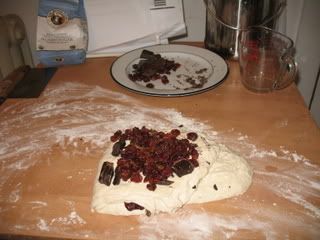
Laurel Robertson, I owe you an apology. I pulled a loaf of Desem bread out of my oven about an hour ago, and, unable to wait any longer, just cut a slice to eat. Without doubt, it is the most delectable, fully flavored whole wheat loaf I have ever eaten. Why it took me this long to get it right, I don't know. But I'm glad I did. When I'm making dinner bread from now on, I'll be making this.
First of all, folks should know that I didn't use a starter made according to the methods described in The Laurel's Kitchen Bread Book , which requires 10 lbs of freshly ground flour. I'm sure you can make it that way, but there's an easier method. I just took some of my regular whole wheat sourdough starter, created a dough ball at about 60% hydration when I fed it, and left it in my chilly (55 degrees F) basement to ripen. I fed it once a day for three days, building it up each time, until I had about 200 grams or roughly 7 ounces of dough. On the final build, I increased its size by a factor of 3, and let it ripen for about 16 hours at 55 degrees, more out of convenience and necessity than calculation. If you don't have a whole wheat starter, it's simple to convert. Just take some of your regular ripe starter, and feed it in the following weight ratio of 1:4:4 -- starter: water: whole wheat flour. Refresh it two or three times like this, and you'll have your 99.99% whole wheat starter. (I won't tell anyone if you don't that it's not absolutely pure).
, which requires 10 lbs of freshly ground flour. I'm sure you can make it that way, but there's an easier method. I just took some of my regular whole wheat sourdough starter, created a dough ball at about 60% hydration when I fed it, and left it in my chilly (55 degrees F) basement to ripen. I fed it once a day for three days, building it up each time, until I had about 200 grams or roughly 7 ounces of dough. On the final build, I increased its size by a factor of 3, and let it ripen for about 16 hours at 55 degrees, more out of convenience and necessity than calculation. If you don't have a whole wheat starter, it's simple to convert. Just take some of your regular ripe starter, and feed it in the following weight ratio of 1:4:4 -- starter: water: whole wheat flour. Refresh it two or three times like this, and you'll have your 99.99% whole wheat starter. (I won't tell anyone if you don't that it's not absolutely pure).
I screwed up my math in preparing the dough, so I ended up with about 38% of the flour as starter rather than the 30% I'd hoped for, but I'm not sure it would make that much difference. You do want a fairly large amount of starter, if I'm reading Laurel's recipe right -- somewhere in the range of about 30%. I also went for the customary 2% salt and aimed at a hydration of 75%.
Here's my formula:
- Whole wheat flour: 100%
- Water: 75%
- Salt: 2%
- 30% of the flour was pre-fermented at 60% hydration.
That worked out to roughly:
- 220 grams starter
- 260 grams water
- 320 grams flour
- 8 grams salt
I mixed it up and kneaded for about 300-400 strokes, until I could stretch a small piece of it into a translucent film (i.e. the "windowpane" test). As for consistency, I was aiming for dough that felt very tacky, but not exactly sticky. Then I formed it into a ball and let it ferment for four hours at about 64 degrees F (the temperature of my kitchen). It more than doubled in size and when I poked a wet finger into the dough, it didn't readily spring back.
Next, I gave the dough a stretch and fold, let it rest 15 minutes, and then shaped it into a ball. I placed it in a banneton (well-floured) and then used my makeshift proof-box to keep it at roughly 85 degrees for 2.5 hours. At that point, the dough had inreased about 75% in size -- perhaps it even doubled. In any case, I slashed it and put it into my cloche, which had been warming in a preheated, 500 degree F oven for about an hour. I had a slight mishap getting it into the cloche (I was a bit too forceful with the peel, and slammed the loaf into the side of the cloche, turning it over on its side. It mushed it a bit, but nothing serious -- the bake took care of it, mostly. You can see the dent on the bottom right of the loaf above.). I repositioned the bread and covered it. The bake was 30 minutes covered at 500, then 15-17 minutes uncovered at 450. I let it cool for one hour.

As you can see, the crumb does not have the huge holes one expects in white bread (I'm just about convinced that any "whole wheat bread" that has sports huge holes probably consists of at least 50% white flour), but, even so, the bread is not at all heavy or dense. The crumb is light and chewy, with a wonderful crispy crust. The flavor? It's tangy, but not overpoweringly so. There's a buttery undertone, maybe? The flavor lingers long in the mouth after eating. Really, the flavor is tough to describe aside from being complex and delicious.
Like I said, when I have company in the future,
this is the bread I'll serve. Utterly delicious.
Well done, Laurel Robertson. And thank you.





 Cover the bowl with plastic or a plate, and let it sit at room temperature (about 70 degrees F, more or less) for about 12 hours (anywhere from 10-14 should be fine). Once it's ready, it should look something like the photo to the left.
Cover the bowl with plastic or a plate, and let it sit at room temperature (about 70 degrees F, more or less) for about 12 hours (anywhere from 10-14 should be fine). Once it's ready, it should look something like the photo to the left.


 Now, after letting the dough rest for 15 minutes, gently shape the dough into a boule, and place it in a well-floured banneton. I splurged a while back and bought one of my own, but you can easily construct a makeshift banneton out of a bowl and a well-floured linen napkin.
Now, after letting the dough rest for 15 minutes, gently shape the dough into a boule, and place it in a well-floured banneton. I splurged a while back and bought one of my own, but you can easily construct a makeshift banneton out of a bowl and a well-floured linen napkin.  I like to let my sourdough proof in the makeshift proof-box you see to your right. I pour a cup or two of boiling water in there and close it up. It'll stay within 3-4 degrees of 85 degrees F for about 90 minutes. I then pour in another cup or two of hot water.
I like to let my sourdough proof in the makeshift proof-box you see to your right. I pour a cup or two of boiling water in there and close it up. It'll stay within 3-4 degrees of 85 degrees F for about 90 minutes. I then pour in another cup or two of hot water. After 3 hours, my bread looked like this.
After 3 hours, my bread looked like this.









